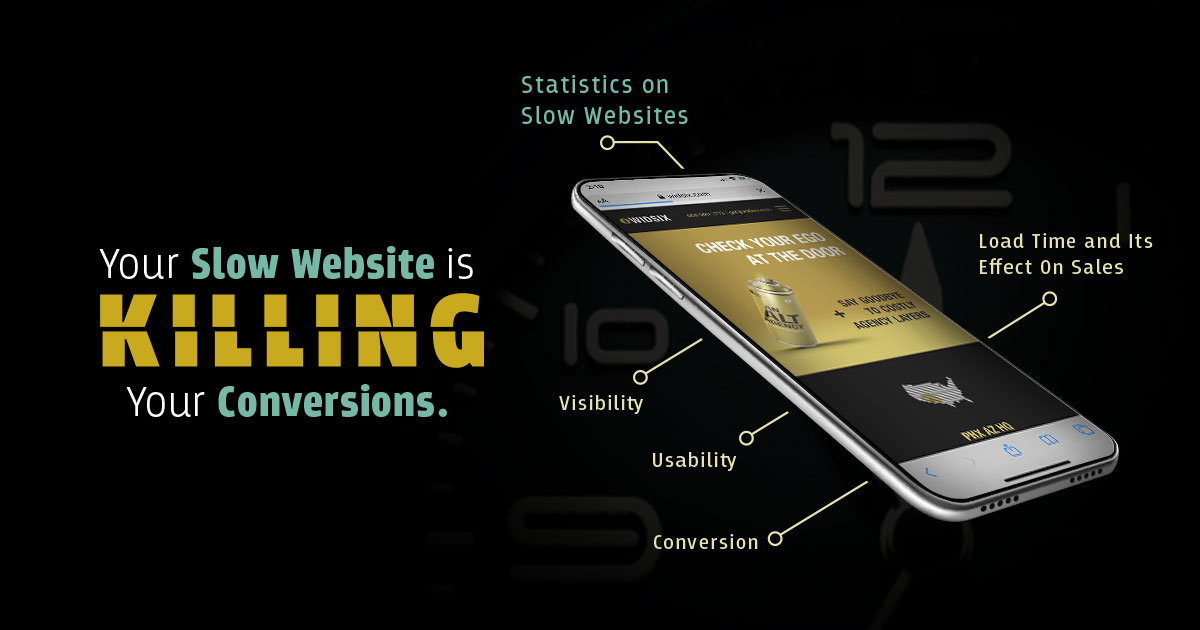// WIDSIX WRITTEN WORD //
Your Slow Website is Killing Your Conversions
The online world has grown exponentially over the last few years, and it is safe to say that many people are now moving their businesses online, with some even starting to depend completely on their online ventures. However, when something starts growing, more people shift their focus to it and that’s when intense competition begins. To crack this competition and make sure your business stays at the top priority of your customers, you will have to ensure that the online shop you so lovingly have established, is working smoothly. And what’s the first step in a website being smooth? The loading speed.
Studies and research have shown time and time again that a website’s speed is a very crucial factor that determines whether or not you will attract customers. The importance of website load speed has been stressed over time, and there’s no better way to put it than to mention that even a two-second delay in load time can increase your bounce rate by a whopping 32 percent. And if digital marketing is all that you breathe, you know should know just how important this is.
How is Load Time Important?
Many people still find it hard to believe that even though their site is loaded with quality content and/or exclusive products, there are not many visitors. Do they still wonder why fast sites make more money? Long story short, because no one likes a slow website that’s taking ages to load.
A great way to understand this is to look at it from the user’s perspective. Suppose you visited a blog looking for informative articles. You visited a website that takes around 4-5 seconds to load an article, and another that takes only 1-2 seconds to load the same page. Is it hard to tell which one would you prefer?
Statistics say that approximately 14 percent of your audience will choose another website if your page load time is too long, and 23 percent will completely stop the shopping experience and move away from their systems. And when you think about it, upsetting a customer can be a huge loss for your business.
To achieve immense marketing success, you must get your website, images, videos, and text to load quickly. Ideal page load time for websites is known to be 3 seconds or less, but average e-commerce websites can take even 7 seconds to load, which is an extremely huge gap.
Load Time and Its Effect On Sales
Needless to say that once your online store is filled with speed issues, you are losing tons of potential customers who can bring value to your brand. This directly impacts your sales and dents your business more than you can ever think. Also, when you dissatisfy potential or existing customers, 40 percent of them won’t even hesitate to talk about how poor their experience was with your business.
Word-of-mouth marketing is something that works on autopilot and costs you nothing. The only effort you ever need to put in is by serving your customers the way they like. Once you do that, you will see profits reflecting on your reports. However, upsetting customers can backfire and end up being a loss for your business.
About 80 percent of these dissatisfied customers are less likely to buy again from the website where they faced the issue. Meaning? Huge loss in terms of returning visitors. And if you are an e-commerce business, returning customers is all that you need (along with new ones, of course).
Statistics on Slow Websites
Here are some stats about how slow websites interfere with the user experience.
- Around 46 percent of people admit that waiting for pages to load is what they dislike the most while browsing the internet.
- On average, it takes around 5-6 seconds to load a mobile landing page. However, if you really want to boost your sales, aim for a load time of at most three seconds.
- Websites with a load time of 5 seconds see a 70 percent longer sessions compared to those with a load time of 19 seconds.
- Pages that loads within 2 seconds have a bounce rate of 9 percent, whereas those with a 5-6 second load time see a 38 percent bounce rate.
- Wonder what 0.1 seconds can do to your conversion rates? A 0.1-second delay can decrease conversion rates by 7 percent, whereas a full second can decrease conversion by 70 percent.
- More than 73 percent of mobile users report that they have encountered websites that take too long to respond.
- Approximately 79 percent of online shoppers who have experienced site performance issues say that won’t return to the site to purchase again.
The Cost of Slow Website
Sure, conversions are the most precious things that a slow website can take away from your business. However, there are other factors along with the conversion rate that a slow website can cost you. They are as follows:
Usability
The responsiveness of your website to user requests and the load time can severely impact your user’s loyalty. However, it is quite evident from the fact that if your site is performing better, it accounts for an enhanced user satisfaction which strengthens the existing customer base and even attracts new ones.
Visibility
Do you know there are tons of factors Google checks before ranking a website? Site speed is one of the ranking factors that Google incorporates into its algorithms to determine ranks on the Search Engine Results Page (SERP). That means that if you are planning to rank on the elite first page of Google Search, your site speed has to be good. Google wants its customers to have a great user experience and this is why they choose only the sites which are best for their users.
Conversion
And of course, the conversion rate. A slow website strangulates conversions and pushes your business to a dead end. Around 47 percent of the customers expect a site to load in two seconds at most. Otherwise, they switch to another website which is even worse for your website conversion rates.
Conclusion
No business wants to upset their existing customers and lose the new ones. It is then imperative to make sure your online platform meets all the quality standards that a normal user would like to experience. Load time is one of the most important parameters to determine whether or not the audience will enter your online shop. The first impression decides your future relationship with the customers.





